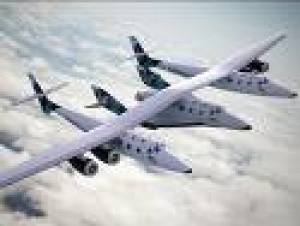Virgin Galactic takes one step closer to reality

Richard Branson’s commercial space venture Virgin Galactic has taken a key technogical step closer to taking tourists into space.
For the first time, Virgin Galactic’s spacecraft, called SpaceShipTwo, has deployed its twin tail sections in a position designed to allow it to softly return to the Earth’s atmosphere from space.
The achievement is fundamental to reducing wear and tear on the rocket, so it can reach achieve the goal of making several flights per day.
Instead of launching a rocket directly into space, a plane will fly SpaceShipTwo under its wing to 50,000 feet, where it will separate and blast off. The craft will climb to the edge of space, or about 60 miles above the Earth’s surface.
During the test, SpaceShipTwo was taken to 51,500 feet by the carrier aircraft, known as WhiteKnightTwo, and dropped.
ADVERTISEMENT
In its free fall, the test pilot rotated the tail section upward to create aerodynamic drag, or “feathering”, allowing it to fall to Earth more like a badminton shuttlecock than a bullet.
George Whitesides, Virgin Galactic’s chief executive, said in a statement that the test flight was SpaceShipTwo’s third in 12 days, “reinforcing the fast turnaround and frequent flight-rate potential of Virgin Galactic’s new vehicles.”
“We have also shown this morning that the unique feathering reentry mechanism, probably the single most important safety innovation within the whole system, works perfectly,” he said.
Virgin Galactic, founded by Branson, hopes to make its first passenger flight sometime next year from the yet-to-be-finished Spaceport America in New Mexico. The company said it has taken about 410 reservations for a ride.
At that suborbital altitude, passengers will experience weightlessness and see the curvature of the Earth. The cost of a flight is currently $200,000 but is expected to fall as the technology evolves.

